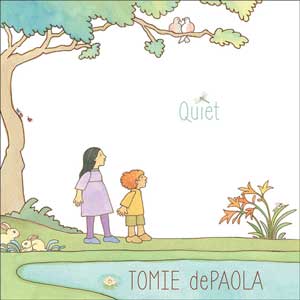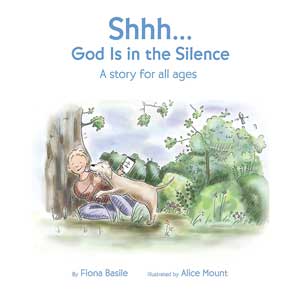Quiet AND Shhh…God Is in the Silence
Reviewed by Paul Buckley
May 1, 2019
 Quiet
Quiet
By Tomie dePaola. Simon & Schuster Books for Young Readers, 2018. 32 pages. $17.99/hardcover; $10.99/eBook. Recommended for ages 4–8.
Buy from QuakerBooks
Shhh…God Is in the Silence: A Story for All Ages
By Fiona Basile, illustrated by Alice Mount. Loyola Press, 2018. 26 pages. $8.95/paperback. Also available in a bilingual Spanish/English edition. Recommended for ages 2 and up.
When I was a parent of young children, I looked for books that would help me to introduce waiting worship to them. I found many that were aimed at adults but none that were for children. There has been a steady stream of books on silence or quietness—some of them very good—but none on what we, as Friends, believe can be found deep in the stillness.
Just in the last few years, we have seen a catalog of different kinds of quiet (Deborah Underwood and Renata Liwska, The Quiet Book, 2010), a listing of the sounds that can be heard within silence (Lemniscates, Silence, 2012), and a description of how quietness is the foundation within which sounds are nestled (Katrina Goldsaito and Julia Kuo, The Sound of Silence, 2016, reviewed in the May 2017 Friends Journal). None of these is about stillness itself or what we can expect to find within it. I had hoped that Thich Nhat Hanh’s A Handful of Quiet (2012, reviewed in the August 2013 Friends Journal) might fill the need, but that book is essentially a how-to on Buddhist meditation for parents to share with their children. The emphasis is on techniques for finding a state of calm awareness, not on the spiritual dimension that we can discover in waiting worship.
These are each good books to share with your children or, in my case, with grandchildren. They just aren’t designed or intended to introduce Quaker worship to young children. If that’s what you are seeking, two new books may be just what you want.
The first is by Tomie dePaola who has written and illustrated more than 250 books for children. In 2011, he was awarded the Laura Ingalls Wilder Medal for his body of work by the Association for Library Service to Children. Quiet is a worthy addition to his corpus and one that will be of special interest to Friends.
In the first half of the book, a young boy and girl are walking in nature with their grandfather. They notice all the activities that the animals, frogs, birds, and insects are engaged in. Then the grandfather suggests that they sit together on a quiet bench. As they watch, the commotion dissipates and the girl says, “I can think, when I’m quiet.” Her brother adds, “I can see, when I’m still.” The book closes with a two-page spread of them and the words, “To be quiet and still is a special thing.” While dePaola’s book has no explicit spiritual element, it could be a useful tool to guide children into a period of worship. You might read it and ask children what else they can discover within themselves when they are still.
 Even more useful for young children is the second book. Although it seems to have been written to lull a young child to sleep, Shhh…God Is in the Silence could be used as a path into waiting worship. Each page repeats the title and asks, “Can you hear him?” Then it presents a loving attribute of the Divine in a few lines of blank verse. A peaceful illustration appears on the facing page. The language is simple, gentle, loving, and affirming, ending with, “And know that God is always in your heart.” In a First-day school class, you could gather into a circle and read it out loud as a way to begin a period of waiting worship.
Even more useful for young children is the second book. Although it seems to have been written to lull a young child to sleep, Shhh…God Is in the Silence could be used as a path into waiting worship. Each page repeats the title and asks, “Can you hear him?” Then it presents a loving attribute of the Divine in a few lines of blank verse. A peaceful illustration appears on the facing page. The language is simple, gentle, loving, and affirming, ending with, “And know that God is always in your heart.” In a First-day school class, you could gather into a circle and read it out loud as a way to begin a period of waiting worship.
If this book has one fault, it is that God is always referred to with masculine pronouns. This is a minor stumbling block, easily remedied when reading aloud by replacing the personal pronouns with other descriptors, such as “God” or “the Spirit,” or simply by alternating between “he” and “she.” The result is equally sweet and more inclusive.
It isn’t easy to introduce Quaker silent worship to children, but it is at the heart of what it means to be a Friend and one of the greatest gifts we can give them. I recommend these two books as valuable entries.



Comments on Friendsjournal.org may be used in the Forum of the print magazine and may be edited for length and clarity.